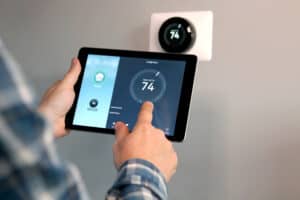The temperature of your house is essential because it keeps you comfortable. Hence, keeping the temperature from getting too hot or chilly is necessary. This way, you can ensure that your family won’t suffer from extreme heat or cold.
Here are seven tips for adequately regulating the temperature on your property:
1. Check HVAC Systems
Heating, ventilation, and air conditioning (HVAC) systems are essential for your home. They help you regulate your temperature by controlling the flow of cool or warm air. However, if your HVAC system isn’t working correctly, it could affect your home’s atmosphere.
A broken thermostat or a faulty air conditioner can cause you to spend more money on utilities than necessary. An excellent way to avoid this problem is by checking out an HVAC guide online to figure out the different types of HVAC heating and cooling systems.
In addition, an HVAC guide can give you insights on how to maintain your HVAC system’s efficiency levels or invest in new ones that can be well-suited for your home.
2. Maintain The Air Ducts
Mice, rats, and cockroaches can cause damage to your air ducts. They can also bring mould and mildew, affecting your home’s air quality. If you inhale these contaminants, this might lead to health issues like allergies and asthma.
To prevent this, regularly check the condition of your air ducts. You can vacuum them regularly and check if there are any holes or cracks in the walls or ceiling of your home. Also, it can help keep your air ducts clean and functional for home temperature regulation.
3. Seal Doors And Windows Properly
During winter, you want to keep your home as warm as possible. However, keeping your doors and windows open might let the cold air in and make it harder for your heating system to do its job.
An excellent way to ensure that your home stays at a comfortable temperature is to seal up any cracks or holes in your property’s walls, doors, and windows. You may use caulk or foam insulation if you want something more permanent. Sealing cracks and holes help ensure that no cold air can get into your home, especially during winter.

4. Purchase A Smart Thermostat
Another way to regulate your home’s temperature is to use a smart thermostat. You can attach this device to an existing heating and cooling system, enabling you to control it remotely through a smartphone app. A smart thermostat is also a great way to save money on your energy bill.
When buying a smart thermostat, check if it’s compatible with a mobile device. Some brands still don’t have this feature, which might make it hard to control your home’s temperature.
5. Use Energy-Efficient Appliances
The light bulbs and appliances inside your home may also affect its temperature. For instance, if you’re using an old refrigerator or air conditioner, these appliances will consume more energy than newer ones do. Hence, it’s best to buy efficient new ones.
Energy-efficient appliances use less power than older models and help reduce greenhouse gas emissions. This can help you improve your home’s temperature because less energy is needed to run them.
6. Insulate Your Home
Insulating the walls and ceilings of your home is another way to regulate its temperature easily. It involves adding insulation panels inside your walls, installing a new window, or sealing any cracks in the house.
Alternatively, you may install spray foam insulation for maximum efficiency and effectiveness. This material will keep hot air from escaping through the walls and windows, minimizing energy costs during summer.
7. Proper Ventilation
During the hot summer months, the last thing you want is to suffer from excessive heat in your home. You can avoid this by turning the fan on to keep you cool. However, ensure you have proper ventilation to prevent this machine from overheating.
You can also open the windows and doors to allow fresh air to enter. This will help get your home in shape by keeping it at an optimal temperature.
Key Takeaway
To get the most out of your home energy usage, it helps to ensure your home’s temperature is as consistent as possible. Consequently, heating and cooling system doesn’t have to work hard in providing your home the right temperature. It’ll also help you save money over time.
Regulating your home’s temperature involves many factors. These include sealing all openings to prevent the cool winter air from getting indoors, getting rid of old appliances, and having proper ventilation. These tips will make your home more comfortable all year round without worrying about high utility bills.

Recent Comments